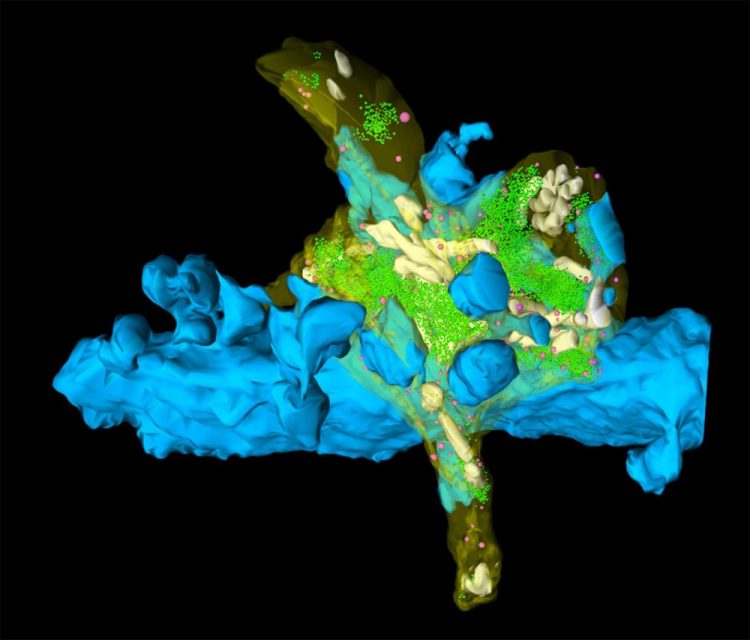Full detonation in the hippocampus

A 3-D volume reconstruction of an adult hippocampal mossy fiber bouton and its target structure, a dendritic segment of a CA3 pyramidal cell dendrite. Color code: dendrite and spiny excrescences in blue, bouton in transparent yellow, mitochondria in white, synaptic vesicles in green and dense-core vesicles in magenta. Courtesy of Astrid Rollenhagen and Joachim Lübke; for details see Rollenhagen et al., J. Neurosci. 27: 10434-10444 (2007)
Synapses form connections between neurons. Their network is intricate: a single postsynaptic neuron can be connected with thousands of presynaptic neurons. At the synapse, information is transferred from the presynaptic to the postsynaptic neuron. A key factor in information processing is the strength of the synapse.
The neuromuscular junction, the connection between neuron and muscle, and the calyx of Held, a synapse in the auditory brainstem, are strong synapses. Also called full detonators, when one of these presynaptic neurons sends out a single activating signal or action potential, the postsynaptic neuron fires.
Whether such detonators also exist in the cortex of the brain has been unclear. In the present study, the authors investigate the synapse between granule cells and CA3 pyramidal cells in the hippocampus, using a recently developed method to simultaneously stimulate the individual presynaptic terminal and record from the connected postsynaptic CA3 neuron.
Under normal conditions, a single action potential from the granule cell does not induce firing in the CA3 neuron. Instead, the granule cells are 'conditional detonators': burst firing of action potentials from a granule cell is required to get the CA3 neuron to fire as well.
But when the researchers altered the synaptic plasticity of the granule cell by stimulating a single presynaptic terminal to fire at high frequency for only one second, causing post-tetanic potentiation (PTP), the picture changes. The granule cell turns into a full detonator: a single action potential causes the CA3 neuron to fire. Peter Jonas explains the significance of their study:
“It is generally thought that individual synapses in the brain are weak, and that tens or hundreds of inputs have to be integrated to activate a neuron. The present paper challenges this view, showing that full detonator synapses exist in the brain. This has important implications for higher order computations in the circuit.”
Short-term synaptic plasticity in the form of PTP produces a computational switch at the studied synapse. This change is prolonged, lasting for tens of seconds. This could be critical for information coding, storage and recall in the network formed by granule cells and CA3 neurons, as Nicholas Vyleta points out:
“A single hippocampal mossy fiber synapse can produce an action potential in a postsynaptic pyramidal neuron after activity-dependent enhancement of transmitter release. This computational switch may allow a single piece of highly specific information from the dentate gyrus to be transmitted through the hippocampal formation, and may form the basis of the processing of information in this circuit by pattern separation.”
The study was published in eLife, an open access journal for the life sciences and biomedicine. The journal is supported by the Howard Hughes Medical Institute, the Max Planck Society and the Wellcome Trust. For Carolina Borges-Merjane and Nicholas Vyleta, publishing their new findings in the open access journal provides several advantages:
“Publishing our work in eLife maximizes the impact of our research and availability to other scientists. eLife has already been well recognized as a reliable journal, with efficient peer-review by scientists from many fields. Our experiences with reviewers and the editor were fair, efficient and their comments were very constructive. Plus the paper is available freely not just to other scientists, but also the general public, including our families. “
Media Contact
All latest news from the category: Life Sciences and Chemistry
Articles and reports from the Life Sciences and chemistry area deal with applied and basic research into modern biology, chemistry and human medicine.
Valuable information can be found on a range of life sciences fields including bacteriology, biochemistry, bionics, bioinformatics, biophysics, biotechnology, genetics, geobotany, human biology, marine biology, microbiology, molecular biology, cellular biology, zoology, bioinorganic chemistry, microchemistry and environmental chemistry.
Newest articles

Recovering phosphorus from sewage sludge ash
Chemical and heat treatment of sewage sludge can recover phosphorus in a process that could help address the problem of diminishing supplies of phosphorus ores. Valuable supplies of phosphorus could…

Efficient, sustainable and cost-effective hybrid energy storage system for modern power grids
EU project HyFlow: Over three years of research, the consortium of the EU project HyFlow has successfully developed a highly efficient, sustainable, and cost-effective hybrid energy storage system (HESS) that…

After 25 years, researchers uncover genetic cause of rare neurological disease
Some families call it a trial of faith. Others just call it a curse. The progressive neurological disease known as spinocerebellar ataxia 4 (SCA4) is a rare condition, but its…





















